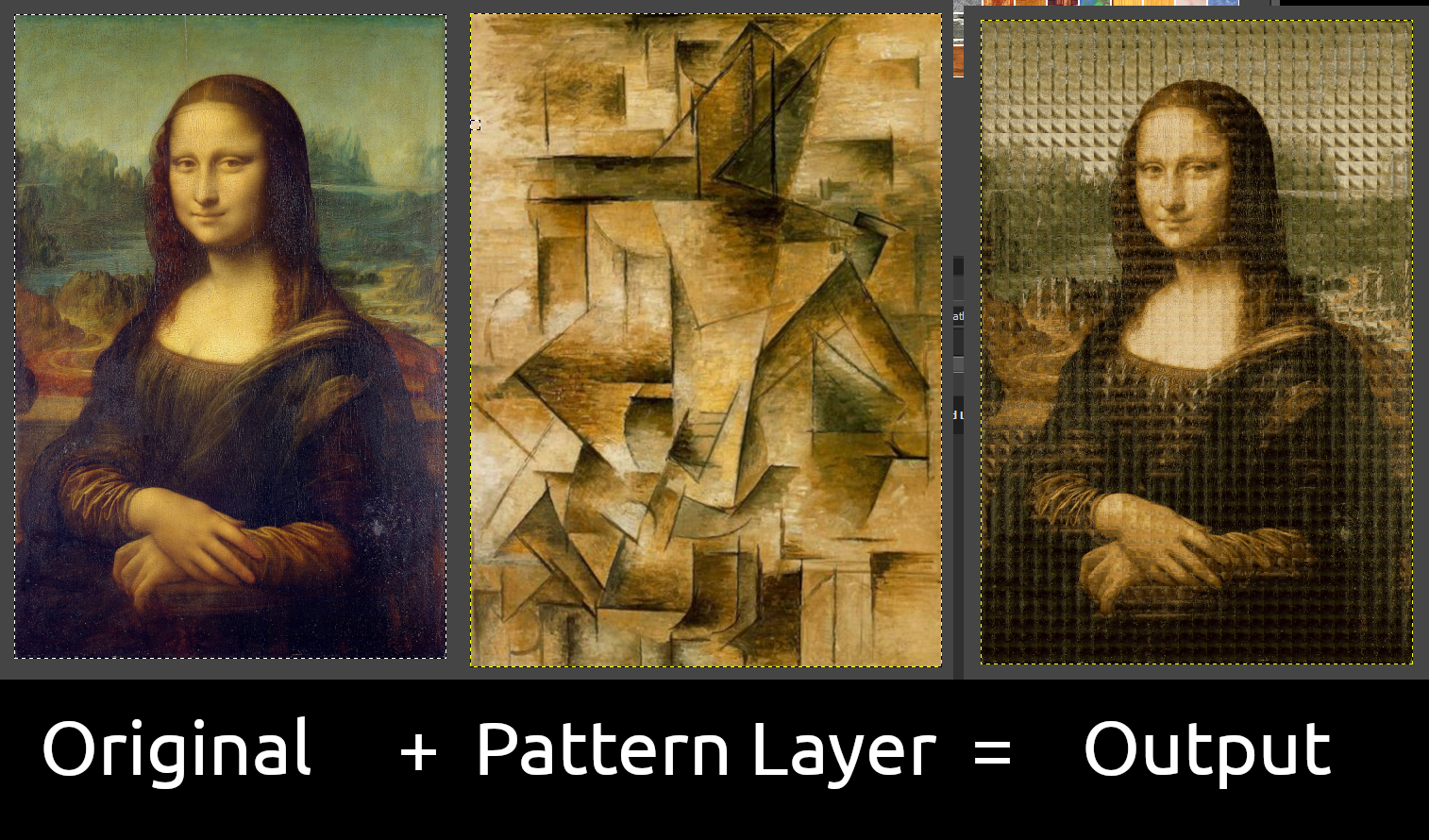
Open 2 images, one as original, another as pattern image layer.
Run plug in on original, select pattern layer/image as pattern, choose number of colors, and method (Closest Gray Scale or Closest Colors) then OK
that's it.
The example above was run with 24 colors and Closest colors method.
Here's the code (just save as .py file [ie. image-pattern.py]) then it'll be available under /Python-Fu/Image Pattern...
Code: Select all
#!/usr/bin/env python
# image-pattern.py
# Created by TT
#
# License: GPLv3
# This program is free software: you can redistribute it and/or modify
# it under the terms of the GNU General Public License as published by
# the Free Software Foundation, either version 3 of the License, or
# (at your option) any later version.
#
# This program is distributed in the hope that it will be useful,
# but WITHOUT ANY WARRANTY# without even the implied warranty of
# MERCHANTABILITY or FITNESS FOR A PARTICULAR PURPOSE. See the
# GNU General Public License for more details.
#
# To view a copy of the GNU General Public License
# visit: http://www.gnu.org/licenses/gpl.html
#
#
# ------------
#| Change Log |
# ------------
# Rel 1: Initial release
from gimpfu import *
import random
import math
def python_image_pattern(image, layer, patternlayer, colors, method):
# pdb.gimp_image_undo_group_start(image)
# pdb.gimp_context_push()
#YOUR CODE BEGINS=======================
method = int(method)
#if we're doing grayscale then we convert grayscale first
if (method == 0):
pdb.gimp_image_convert_grayscale(image)
#reduce it down to colors
pdb.gimp_image_convert_indexed(image,0,0,int(colors),FALSE,FALSE,"IGNORE PALETTE TYPE")
num_bytes,colormap = pdb.gimp_image_get_colormap(image)
#back to rgb
pdb.gimp_image_convert_rgb(image)
cols = []
tilesize=45
patternimage = pdb.gimp_item_get_image(patternlayer)
for y in range(0,int(math.floor(patternlayer.height/tilesize))):
pdb.gimp_progress_update(float(y)/int(math.floor(patternlayer.height/tilesize)))
for x in range(0,int(math.floor(patternlayer.width/tilesize))):
pdb.gimp_image_select_rectangle(patternimage,CHANNEL_OP_REPLACE,x*tilesize,y*tilesize,tilesize,tilesize)
r,std_dev,median,pixels,count,percentile = pdb.gimp_histogram(patternlayer,HISTOGRAM_RED,0,255)
g,std_dev,median,pixels,count,percentile = pdb.gimp_histogram(patternlayer,HISTOGRAM_GREEN,0,255)
b,std_dev,median,pixels,count,percentile = pdb.gimp_histogram(patternlayer,HISTOGRAM_BLUE,0,255)
cols.append([[r,g,b],[x,y],0])
# num_patterns,patterns_list = pdb.gimp_patterns_list("")
# for i in range(1,len(patterns_list)):
# pdb.gimp_progress_update(float(i)/len(patterns_list))
# width,height,bpp,num_color_bytes,color_bytes = pdb.gimp_pattern_get_pixels(patterns_list[i])
# totalr = totalg = totalb = 0
# pixels = 0.0;
# for j in range(0,num_color_bytes/bpp):
# zeroi = bpp*j
# pixels += 1;
# if (bpp >=3):
# r = color_bytes[zeroi]
# g = color_bytes[zeroi+1]
# b = color_bytes[zeroi+2]
# else:
# r = g = b = color_bytes[zeroi] #gray scale
# totalr += r;
# totalg += g;
# totalb += b;
# cols.append([[totalr/pixels,totalg/pixels,totalb/pixels],patterns_list[i],0])
#Here we have the patterns data
new_layer = pdb.gimp_layer_new(image,layer.width,layer.height,RGBA_IMAGE,"GIMP Pattern Layer",100,LAYER_MODE_NORMAL)
pdb.gimp_image_insert_layer(image,new_layer,None,0)
#num_bytes,colormap = pdb.gimp_image_get_colormap(image)
bpp = num_bytes/int(colors);
num_patterns,patterns_list = pdb.gimp_patterns_list("")
pdb.gimp_context_set_pattern(patterns_list[0]) #clipboard
for i in range(0,int(colors)):
zeroi = bpp*i;
r = colormap[zeroi];
g = colormap[zeroi+1];
b = colormap[zeroi+2];
color = (r,g,b);
#pdb.gimp_by_color_select(layer,color,0,CHANNEL_OP_REPLACE,TRUE,FALSE,0,FALSE)
#now get the pattern that matches closest
for j in range(0,len(cols)):
if (method==0):
grayvalue = (cols[j][0][0]+cols[j][0][1]+cols[j][0][2])/3.0
diff = ((r-grayvalue)*0.3)**2 + ((g-grayvalue)*0.59)**2 + ((b-grayvalue)*0.11)**2;
else:
diff = ((r-cols[j][0][0])*0.3)**2 + ((g-cols[j][0][1])*0.59)**2 + ((b-cols[j][0][2])*0.11)**2;
cols[j][2] = diff
#sort by index 2 with is diff values
cols.sort(key=lambda x: x[2])
#pdb.gimp_context_set_pattern(cols[0][1])
x = cols[0][1][0];
y = cols[0][1][1];
pdb.gimp_image_select_rectangle(patternimage,CHANNEL_OP_REPLACE,x*tilesize,y*tilesize,tilesize,tilesize)
pdb.gimp_edit_copy(patternlayer)
pdb.gimp_by_color_select(layer,color,0,CHANNEL_OP_REPLACE,TRUE,FALSE,0,FALSE)
pdb.gimp_edit_fill(new_layer,FILL_PATTERN)
pdb.gimp_selection_none(image)
#YOUR CODE ENDS ========================
# pdb.gimp_context_pop()
# pdb.gimp_image_undo_group_end(image)
pdb.gimp_displays_flush()
#return
register(
"python_fu_image_pattern",
"Uses Image Patterns to recolor layer image",
"Uses Image Patterns to recolor layer image",
"TT",
"TT",
"March 30, 2023",
"<Image>/Python-Fu/Image Pattern...",
"*", # Create a new image, don't work on an existing one
[
#INPUT BEGINS
(PF_DRAWABLE, "tilepattern", "Layer To Use As Pattern:", None),
(PF_INT, "colors", "Colors:", 8),
(PF_OPTION, "method", "Method:", 0, ["Closest Gray Scale","Closest Color"]),
#(PF_TOGGLE, "method", "Gray/Method:", 1), # initially True, checked. Alias PF_BOOL
# (PF_SPINNER, "colors", "Number of Maximum Colors (randomly):", 16, (1, 32, 1)),
# (PF_TOGGLE, "varysize", "Vary up sizes:", 1), # initially True, checked. Alias PF_BOOL
# (PF_TOGGLE, "colorbackground", "Color background randomly:", 0), # initially True, checked. Alias PF_BOOL
#(PF_SPINNER, "inc", "Increments (pixels):", 15, (1, 1000, 1)),
#(PF_SPINNER, "outof", "Best out of:", 100, (1, 1000, 1)),
#(PF_OPTION, "arrow_side", "Arrows Ends:", SIDE_END, SIDE_NAMES),
#(PF_TOGGLE, "arrow_close", "Arrows Close:", 0),
#(PF_SPINNER, "ignorelayers", "Ignore first (no of layers):", 2, (0, 200, 1)),
#(PF_SPINNER, "shadow_offset_x", "Shadow Offset X:", 6, (-4096,4096,1)),
#(PF_SPINNER, "shadow_offset_y", "Shadow Offset Y:", 6, (-4096,4096,1)),
#(PF_SPINNER, "shadow_blur_radius", "Shadow Blur Radius:", 15, (0,1024,1)),
#(PF_SPINNER, "shadow_opacity", "Shadow Opacity:", 100, (0,100,1)),
#INPUT ENDS
],
[],
python_image_pattern)
main()
# (PF_INT, "p0", "_INT:", 0), # PF_INT8, PF_INT16, PF_INT32 similar but no difference in Python.
# (PF_FLOAT, "p02", "_FLOAT:", 3.141),
# (PF_STRING, "p03", "_STRING:", "foo"), # alias PF_VALUE
# (PF_TEXT, "p04", "TEXT:", "bar"),
# # PF_VALUE
# # Pick one from set of choices
# (PF_OPTION,"p1", "OPTION:", 0, ["0th","1st","2nd"]), # initially 0th is choice
# (PF_RADIO, "p16", "RADIO:", 0, (("0th", 1),("1st",0))), # note bool indicates initial setting of buttons
# # PF_RADIO is usually called a radio button group.
# # SLIDER, ADJUSTMENT types require the extra parameter of the form (min, max, step).
# (PF_TOGGLE, "p2", "TOGGLE:", 1), # initially True, checked. Alias PF_BOOL
# # PF_TOGGLE is usually called a checkbox.
# (PF_SLIDER, "p3", "SLIDER:", 0, (0, 100, 10)),
# (PF_SPINNER, "p4", "SPINNER:", 21, (1, 1000, 50)), # alias PF_ADJUSTMENT
# # Pickers ie combo boxes ie choosers from lists of existing Gimp objects
# (PF_COLOR, "p14", "_COLOR:", (100, 21, 40) ), # extra param is RGB triple
# # PF_COLOUR is an alias by aussie PyGimp author lol
# (PF_IMAGE, "p15", "IMAGE:", None), # should be type gimp.image, but None works
# (PF_FONT, "p17", "FONT:", 0),
# (PF_FILE, "p18", "FILE:", 0),
# (PF_BRUSH, "p19", "BRUSH:", 0),
# (PF_PATTERN, "p20", "PATTERN:", 0),
# (PF_GRADIENT, "p21", "GRADIENT:", 0),
# (PF_PALETTE, "p22", "PALETTE:", 0),
# (PF_LAYER, "p23", "LAYER:", None),
# (PF_CHANNEL, "p24", "CHANNEL:", None), # ??? Usually empty, I don't know why.
# (PF_DRAWABLE, "p25", "DRAWABLE:", None),
# # Mostly undocumented, but work
# (PF_VECTORS, "p26", "VECTORS:", None),
# (PF_FILENAME, "p27", "FILENAME:", 0),
# (PF_DIRNAME, "p28", "DIRNAME:", 0)
# # PF_REGION might work but probably of little use. See gimpfu.py.


